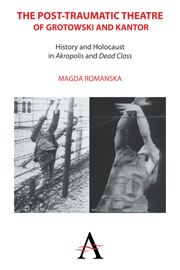 The Post-traumatic Theatre of Grotowski and Kantor
The Post-traumatic Theatre of Grotowski and Kantor from Part II - Our Memory: Kantor's Dead Class
Dead Class was successfully performed all over the world. In each new city, as Klaudiusz Święcicki put it, “Every viewer came to the spectacle with his or her own cultural system of significations. Hence the many interpretations of this work.” Since neither language nor historical context was available to international audiences, foreign critics used other strategies to structure their responses to Kantor's elusive masterpiece. Reading those initial reviews is important because they provide a framework for the process of making meaning, the entire epistemological enterprise that eventually came to surround Kantor's work. The foreign critical response to Kantor's work reflects the innate difficulty of finding a critical framework to address its meaning. Critics’ inability to grasp its geographic, historical, artistic or aesthetic meanings underscores the difficulty with which works like Dead Class are classified, taught and shown. Many foreign critics argued that Kantor's work is intrinsically transnational, even though it clearly bears the marks of its Polish origins. As early as 1977, Raymonde Temkine wrote of Dead Class that although “the performance has a trans-national meaning, one can feel an exceptionally strong sense of Polishness running through it.” Jean-Pierre Leonardini suggested: “To argue that The Dead Class is performed in an exclusively Polish cultural context is misguided.” Nella Bielski saw it in the context of European postmodernism.
To save this book to your Kindle, first ensure [email protected] is added to your Approved Personal Document E-mail List under your Personal Document Settings on the Manage Your Content and Devices page of your Amazon account. Then enter the ‘name’ part of your Kindle email address below. Find out more about saving to your Kindle.
Note you can select to save to either the @free.kindle.com or @kindle.com variations. ‘@free.kindle.com’ emails are free but can only be saved to your device when it is connected to wi-fi. ‘@kindle.com’ emails can be delivered even when you are not connected to wi-fi, but note that service fees apply.
Find out more about the Kindle Personal Document Service.
To save content items to your account, please confirm that you agree to abide by our usage policies. If this is the first time you use this feature, you will be asked to authorise Cambridge Core to connect with your account. Find out more about saving content to Dropbox.
To save content items to your account, please confirm that you agree to abide by our usage policies. If this is the first time you use this feature, you will be asked to authorise Cambridge Core to connect with your account. Find out more about saving content to Google Drive.